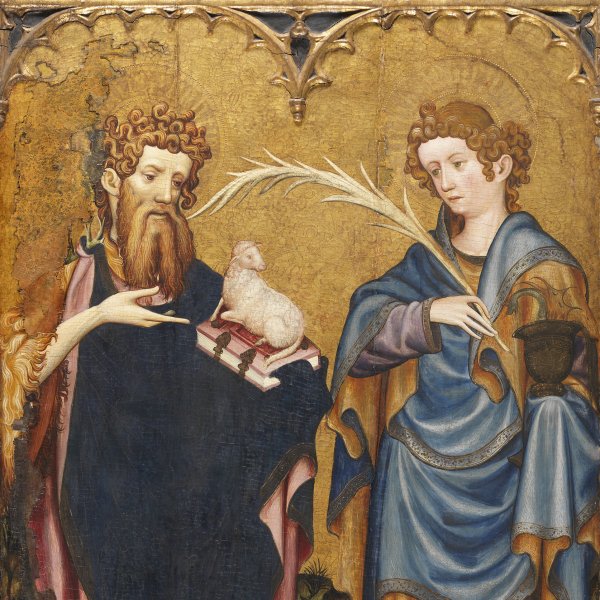Pilgrims' Mass
The panel entitled Pilgrims’ Mass entered the Thyssen-Bornemisza collection in 1985 from a private US collection. In the documentation that accompanied the acquisition the painting was entitled Pilgrims receiving Alms from a Saint and was attributed to Jaume Huguet. In Gertrude Borghero’s catalogue, published one year after the acquisition, it was attributed to an anonymous Spanish artist, an attribution retained by Caroline de Watteville in 1989. The painting, which was first published by Gertrude Borghero, was exhibited for the first time together with other works from the Thyssen- Bornemisza collection at the Real Academia de Bellas Artes de San Fernando in Madrid. In Borghero’s catalogue the panel was entitled Charity: in Watteville’s it was referred to as Almsgiving, while in the Madrid exhibition it was entitled Charity, giving Alms to Pilgrims. The title was revised again in 1992 to become Pilgrims’ Mass, reflecting the role of the liturgical event in the composition. The panel probably formed part of a larger ensemble that was dismantled and dispersed at an unknown date.
The composition represents the celebration of a mass in the background of which a saint, recognisable by his halo, gives alms to a group of ragged pilgrims who line up on the left. The identity of the saint, who was probably the titular saint of the chapel for which this panel was painted, is difficult to determine due to his lack of specific attributes. At the present time no further information is known with regard to other panels that might have been associated with this one and which could provide clues as to the chapel for which it was intended.
Nonetheless, the artist does provide some general clues as to the saint’s identity such as his courtly dress with gold-embroidered sleeves and the ermine trim on his tunic. In addition, he is accompanied by a retinue of figures that stand behind him as he distributes alms, with the whole group standing on a platform next to the altar at which the mass is being said. These details indicate that the saint is a figure of high social and economic standing and a recognised figure in the community.
Despite the use of the floor tiles to create a sense of depth, this anonymous artist was not fully competent in the use of perspective. The space, filled with figures, represents the interior of a Gothic church with bare walls suggesting churches on Spain’s east coast. Elements such as the book and lectern in front of the acolyte in the centre and the altar and the platform on which the officiating priest is standing, are poorly inserted into the composition. This lack of scale also affects the figure of the priest’s assistant on the far right who holds the jugs of wine. The faces are executed with minute detail and have distinctive small mouths with rounded lower lips of a bright red colour. The use of a vigorous line is also evident in the clothes and the drapery that falls in straight lines, particularly those of the two priests.
Mar Borobia







